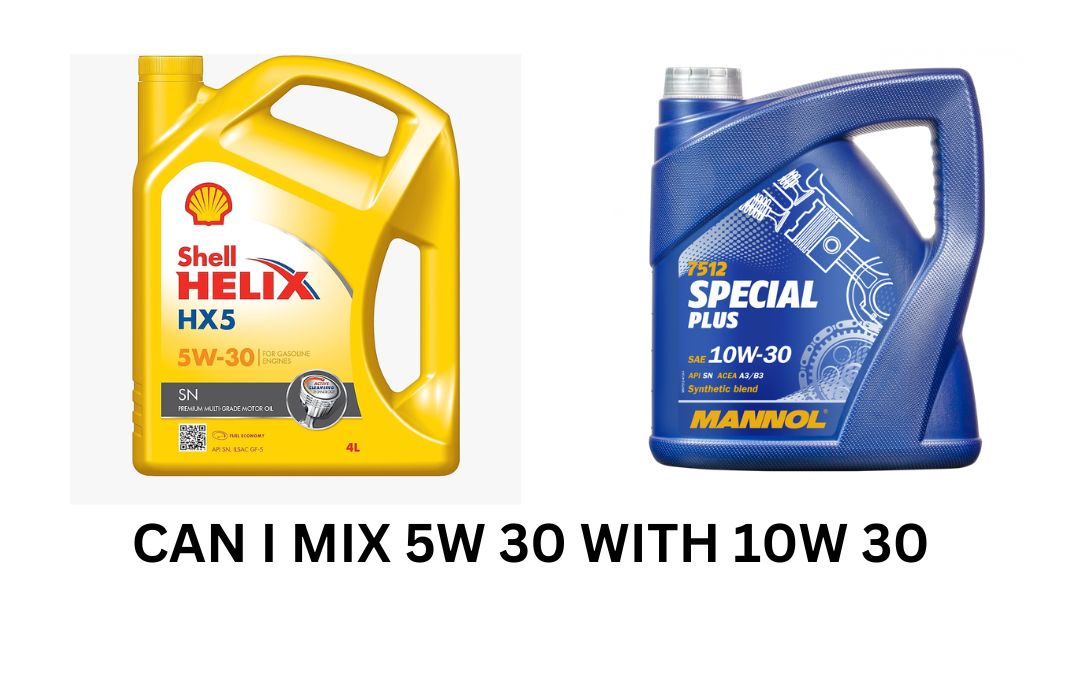Mixing 5w 30 with 10w 30 is permissible as long as the ratio is appropriate, but it is not recommended by most vehicle manufacturers. Both oils have different viscosities and characteristics, and combining them can alter the oil’s protective properties and reduce its effectiveness.
Choosing the right engine oil for your vehicle is crucial for maintaining its performance and longevity. Using the wrong type of oil can damage the engine and lead to costly repairs. 5w 30 and 10w 30 are two of the most commonly used engine oils, and they both have different properties.
5w 30 is a thinner oil that performs well in colder temperatures, while 10w 30 is thicker and better suited for warmer climates. While it is possible to mix the two, it is generally not recommended, and it is always best to follow the manufacturer’s recommended oil type and viscosity.
Understanding 5W 30 And 10W 30 Oil
Are you looking to mix different grades of oil for your car? Before you do, it’s important to understand what you’re putting in your engine. In this section, we’ll discuss the differences between 5w 30 and 10w 30 motor oil and their specific characteristics.
Definition Of 5W 30 And 10W 30 Motor Oil
- 5w 30 motor oil has a viscosity rating of 5 in cold temperatures and 30 in hot temperatures. The “w” in the name stands for “winter,” indicating that it performs well in cold weather.
- 10w 30 motor oil, on the other hand, has a viscosity rating of 10 in cold temperatures and 30 in hot temperatures. This oil is better suited for hotter climates and high mileage engines.
Differences Between The Two Types Of Oil
- The main difference between 5w 30 and 10w 30 motor oil is their cold temperature performance, with 5w 30 being better suited for colder climates.
- 10w 30 motor oil is better suited for hotter climates and higher mileage engines due to its thicker viscosity rating.
- Mixing different grades of oil can affect the oil’s viscosity and performance, potentially causing engine damage.
Characteristics Of 5W 30 And 10W 30 Oil
- 5w 30 motor oil is more fluid and has better flow in colder temperatures due to its lower viscosity rating. This oil is better suited for vehicles used in colder climates.
- 10w 30 motor oil has a higher viscosity rating and performs better in hotter temperatures and high mileage engines than 5w 30.
- Both oils offer protection against wear and tear, rust and corrosion, and sludge buildup in the engine.
- It’s important to choose the correct grade of oil for your engine based on the manufacturer’s recommendations to ensure that it operates efficiently and avoids damage.
While it may be tempting to mix different grades of oil to save money, it’s best to follow the manufacturer’s recommendations for your engine. Using the incorrect oil weight can lead to engine damage and costly repairs.
Can You Mix 5W 30 And 10W 30 Oil?
Factors To Consider Before Mixing The Two Types Of Oil
Before you jump into mixing 5w 30 and 10w 30 oil, it’s essential to know if it’s the best option for your engine. Here are some factors to consider before mixing oil viscosities:
- Check your vehicle owner’s manual for the recommended oil viscosity – this will guide you on the right oil viscosity to use.
- Consider the weather conditions in your area. If you live in a cold climate, then a low viscosity oil such as 5w 30 might work best, whereas if you’re in a hot climate, a higher viscosity oil like 10w 30 might be suitable.
- Check the oil you currently have in your engine. If it’s already a blend of different viscosities, then mixing might not be necessary.
Pros And Cons Of Mixing Different Viscosities
Just like any other thing in life, mixing different oil viscosities has its advantages and disadvantages. Here is what you need to consider:
Pros
- Mixing different oil viscosities can help maintain the right balance of protection and performance in your engine.
- It can be a cheaper alternative to buying new oil that matches with your engine requirements.
- You have the flexibility to adjust and create a custom viscosity blend for your engine, based on your specific needs.
Cons
- When you mix two different oil viscosities, you modify the overall oil viscosity, which can negatively affect your engine’s performance.
- Using a custom blend of oil can void your car warranty if anything goes wrong.
- The lack of precise measurement and consistency when mixing can result in inconsistent engine protection, causing excessive wear and tear.
Effects Of Mixing 5W 30 And 10W 30 Oil
Mixing 5w 30 and 10w 30 oil can have several effects on your engine, both positive and negative. Here’s a brief overview:
- The mix of two different viscosities will affect the overall viscosity of the oil, which may cause damage due to excessive wear and tear.
- Mixing oil viscosities can also affect the flow rate, affecting the engine’s performance as oil flow affects friction and heat.
- In extreme temperatures, a mixture of viscosities can produce harmful deposits, reducing the lifespan of your engine.
Remember, before considering mixing two different oil viscosities together, it’s best to consult your vehicle owner’s manual, speak with a certified mechanic or professional to determine if it is the best course of action.
How To Properly Mix 5W 30 And 10W 30 Oil
Can I Mix 5W 30 With 10W 30?
If you are a car owner, you might have wondered whether it is possible to mix 5w 30 with 10w 30 oil. The good news is that it is not only possible but also safe, provided it is done correctly.
However, it is essential to know the right ratio of mixing oil to avoid damaging the engine. In this blog post, we will explore how to properly mix 5w 30 and 10w 30 oil, tips for mixing oil effectively, guidelines for determining the right ratio of oil, and recommendations from automotive experts.
Tips For Mixing Oil Effectively
Mixing oil is a standard practice amongst car owners. Here are tips to ensure you mix oil effectively:
- Always use the same brand and type of oil
- Mix oil in an empty container to get a consistent ratio
- Carefully measure the amount of oil you need to avoid overfilling or underfilling the engine
- Mix the oil thoroughly to achieve a uniform consistency
- Double-check the oil’s viscosity after mixing to ensure you have the right ratio.
Guidelines For Determining The Right Ratio Of Oil
Determining the right ratio of oil is crucial to avoid engine damage. It is typically recommended to mix 5w 30 and 10w 30 oil in an equal ratio. However, you can alter the ratio depending on climate and weather conditions.
If you reside in a colder region, it is always advisable to use more 5w 30 oil, which is thinner and can quickly flow through the engine in colder temperatures. In contrast, if you live in warmer regions, you can use more 10w 30 oil since it is thicker and can provide better engine protection in warmer conditions.
Recommendations From Automotive Experts
Automotive experts agree that mixing 5w 30 with 10w 30 oil is safe and can provide great engine performance. However, it is advisable to use the same brand and type of oil for consistency. Additionally, when mixing oil, always follow the oil manufacturer’s guidelines and recommendations to avoid damaging the engine.
Mixing 5w 30 with 10w 30 oil is safe and can protect your engine in extreme weather conditions. Always remember to use the right ratio of oil and follow the manufacturer’s guidelines for better engine performance.
Frequently Asked Questions Of Can I Mix 5W 30 With 10W 30
Can I Mix 5W 30 With 10W 30?
Yes, you can mix the two synthetic oils if the specifications of both match.
What Happens If I Mix 5W 30 With 10W 30?
Mixing 5w 30 with 10w 30 will not damage your engine. However, it may affect the efficiency and performance of the engine oil.
Can I Mix Synthetic And Regular Oil Of 5W 30 With 10W 30?
No, combining synthetic and conventional oils is not recommended as it can alter the viscosity of the oil and lead to engine damage.
What Should I Do If I Accidentally Mix 5W 30 With 10W 30?
If you accidentally mix the two oils, it is better to drain the oil and fill the engine with fresh oil of the correct type and viscosity.
What Is The Difference Between 5W 30 And 10W 30?
The difference between 5w 30 and 10w 30 is the thickness of the oil at low temperatures. 5w 30 has less viscosity than 10w 30 at low temperatures, making it more suitable for cold weather conditions.
Conclusion
After exploring the topic of mixing 5w 30 with 10w 30, it is clear that while it may be possible, it is not recommended. Mixing different types of oils can affect the viscosity and performance of the oil, leading to potential engine damage.
It is important to follow the manufacturer’s recommendations for oil viscosity and type, as they are specifically designed to meet the needs of the engine. In addition, it is important to consider the climate and driving conditions when selecting the appropriate oil for your vehicle.
For example, in colder climates, a thinner oil such as 5w 30 may be recommended to ensure proper lubrication during start-up. Ultimately, investing in high-quality, recommended oil for your vehicle can save you time, money, and potential engine damage in the long run.
Do not hesitate to consult with a professional mechanic or reference your owner’s manual for guidance on proper oil selection and maintenance.

